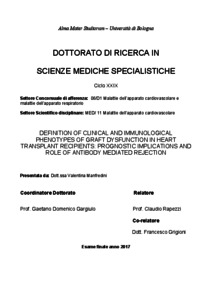Manfredini, Valentina
(2017)
Definition of Clinical and Immunological Phenotypes of Graft Dysfunction in Heart Transplant Recipients: Prognostic Implications and Role of Antibody Mediated Rejection, [Dissertation thesis], Alma Mater Studiorum Università di Bologna.
Dottorato di ricerca in
Scienze mediche specialistiche, 29 Ciclo. DOI 10.6092/unibo/amsdottorato/8015.
Documenti full-text disponibili:
![[img]](http://amsdottorato.unibo.it/8015/1.hassmallThumbnailVersion/manfredini_valentina_tesi.pdf)  Anteprima |
|
Documento PDF (English)
- Richiede un lettore di PDF come Xpdf o Adobe Acrobat Reader
Disponibile con Licenza: Salvo eventuali più ampie autorizzazioni dell'autore, la tesi può essere liberamente consultata e può essere effettuato il salvataggio e la stampa di una copia per fini strettamente personali di studio, di ricerca e di insegnamento, con espresso divieto di qualunque utilizzo direttamente o indirettamente commerciale. Ogni altro diritto sul materiale è riservato.
Download (1MB)
| Anteprima
|
Abstract
Background
Despite its clinical relevance, there is a lack of consensus regarding the definition of graft dysfunction (GD) in heart transplant (HT). Herein we aim to characterize clinical phenotypes of patients with GD, either acute or chronic, comparing their outcomes with stable patients. In addition, we explored the risk factors outcomes in GD patients.
Methods
The patients were divided in 3 groups:
Group A - Patients who recently underwent HT (<5 years); Group B - Patients with clinical and instrumental signs of GD, regardless of the distance of HT; Group C - Stable patients (HT > 5 years).
Primary Endpoints were: overall mortality, hospitalizations for cardiovascular events and hospitalization for all-causes. The Combined Endpoints was death or /and hospitalizations for cardiovascular events (CV hospitalization).
Results
We enrolled 134 consecutive HT patients. Patients with GD 32(24%) had significant higher prevalence of class NYHA >II, low EF, CAV, longer QRS and Qtc on the ECG (p<0.01) and donor specific antibodies (DSA) (all p<0.05), as compared with group A and C. Clinical presentation was highly heterogeneous: 6(19%) had acute presentation, 3 for acute rejection, and 3 for acute coronary syndromes; 21(66%) had chronic presentation: 17(53%) associated with CAV, and 4(13%) as chronic dysfunction after antibody-mediated rejection. During the 2y follow-up, GD patients showed higher mortality (P=0.01) and higher CVE hospitalization rate (54; P< 0.01) than patients in group A and C. Low EF, time from HT, and chronic clinical presentation (p<0.01) were risk factors for the combined endpoint
Conclusions
GD after HT is characterized by highly variable clinical presentation and is correlated with a particularly poor prognosis. CAV is the most frequent etiology, and DSA are more often found in patients with GD than in stable ones, but do not seem to influence outcome.
Abstract
Background
Despite its clinical relevance, there is a lack of consensus regarding the definition of graft dysfunction (GD) in heart transplant (HT). Herein we aim to characterize clinical phenotypes of patients with GD, either acute or chronic, comparing their outcomes with stable patients. In addition, we explored the risk factors outcomes in GD patients.
Methods
The patients were divided in 3 groups:
Group A - Patients who recently underwent HT (<5 years); Group B - Patients with clinical and instrumental signs of GD, regardless of the distance of HT; Group C - Stable patients (HT > 5 years).
Primary Endpoints were: overall mortality, hospitalizations for cardiovascular events and hospitalization for all-causes. The Combined Endpoints was death or /and hospitalizations for cardiovascular events (CV hospitalization).
Results
We enrolled 134 consecutive HT patients. Patients with GD 32(24%) had significant higher prevalence of class NYHA >II, low EF, CAV, longer QRS and Qtc on the ECG (p<0.01) and donor specific antibodies (DSA) (all p<0.05), as compared with group A and C. Clinical presentation was highly heterogeneous: 6(19%) had acute presentation, 3 for acute rejection, and 3 for acute coronary syndromes; 21(66%) had chronic presentation: 17(53%) associated with CAV, and 4(13%) as chronic dysfunction after antibody-mediated rejection. During the 2y follow-up, GD patients showed higher mortality (P=0.01) and higher CVE hospitalization rate (54; P< 0.01) than patients in group A and C. Low EF, time from HT, and chronic clinical presentation (p<0.01) were risk factors for the combined endpoint
Conclusions
GD after HT is characterized by highly variable clinical presentation and is correlated with a particularly poor prognosis. CAV is the most frequent etiology, and DSA are more often found in patients with GD than in stable ones, but do not seem to influence outcome.
Tipologia del documento
Tesi di dottorato
Autore
Manfredini, Valentina
Supervisore
Co-supervisore
Dottorato di ricerca
Ciclo
29
Coordinatore
Settore disciplinare
Settore concorsuale
Parole chiave
Heart Transplantation, Cellular-mediated rejection, Antibody-mediated rejection, Graft Dysfunction, Donor Specific Antibodies
URN:NBN
DOI
10.6092/unibo/amsdottorato/8015
Data di discussione
5 Maggio 2017
URI
Altri metadati
Tipologia del documento
Tesi di dottorato
Autore
Manfredini, Valentina
Supervisore
Co-supervisore
Dottorato di ricerca
Ciclo
29
Coordinatore
Settore disciplinare
Settore concorsuale
Parole chiave
Heart Transplantation, Cellular-mediated rejection, Antibody-mediated rejection, Graft Dysfunction, Donor Specific Antibodies
URN:NBN
DOI
10.6092/unibo/amsdottorato/8015
Data di discussione
5 Maggio 2017
URI
Statistica sui download
Gestione del documento:


 Login
Login
